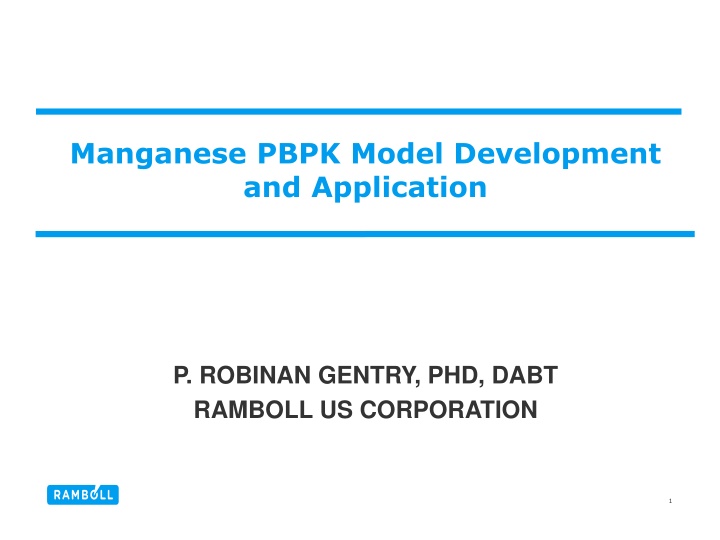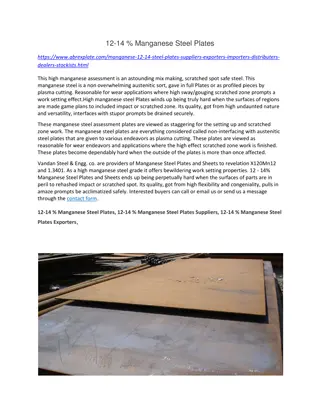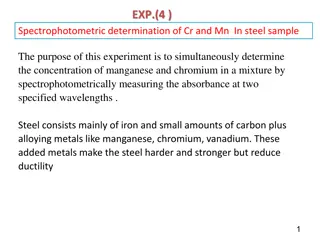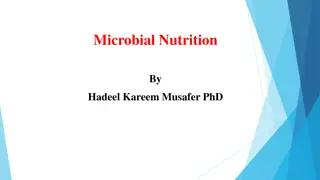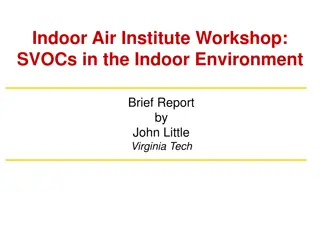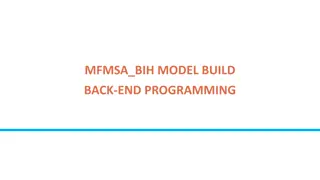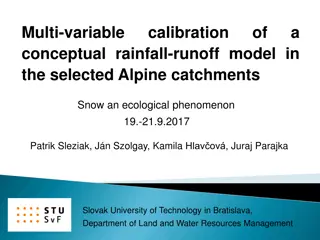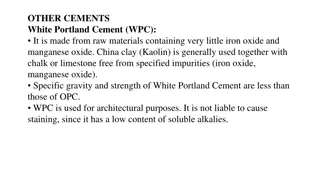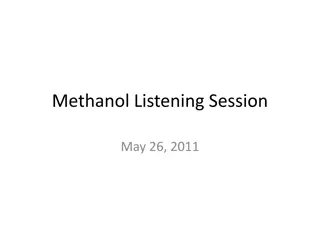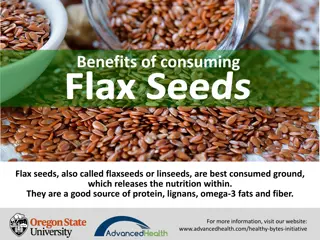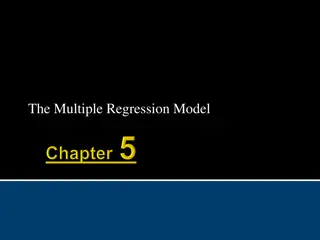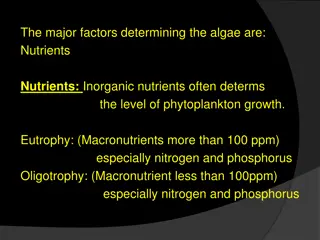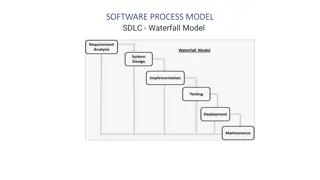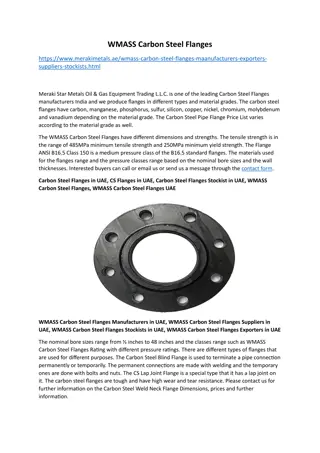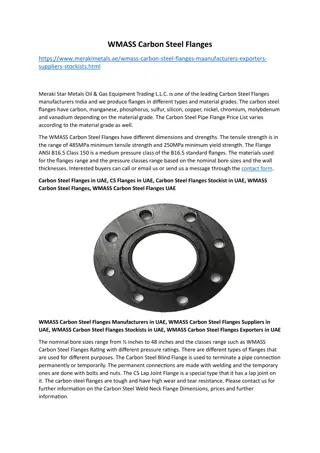Manganese PBPK Model Development and Application
Manganese PBPK models developed in acslX are being converted to R for further simulation. Documentation with Quality Assurance Project Plan has been completed. The application of the model involves addressing challenges in human health risk assessment for manganese exposure using traditional approaches and applying a Margin of Safety approach to estimate the gap between ambient exposures and concentrations associated with health effects.
Download Presentation

Please find below an Image/Link to download the presentation.
The content on the website is provided AS IS for your information and personal use only. It may not be sold, licensed, or shared on other websites without obtaining consent from the author.If you encounter any issues during the download, it is possible that the publisher has removed the file from their server.
You are allowed to download the files provided on this website for personal or commercial use, subject to the condition that they are used lawfully. All files are the property of their respective owners.
The content on the website is provided AS IS for your information and personal use only. It may not be sold, licensed, or shared on other websites without obtaining consent from the author.
E N D
Presentation Transcript
Manganese PBPK Model Development and Application P. ROBINAN GENTRY, PHD, DABT RAMBOLL US CORPORATION 1
MODEL DEVELOPMENT: CONVERSION OF ACSLX MODELS TO R Manganese PBPK models have been developed in acslX which is no longer available; conversion to another simulation package is needed Conversion from acslX to R completed as drinking water was incorporated into the models Human Manganese PBPK Models o Adult Model o Gestation Model o Human Lactation Model Conversion from acslX to R in process Transporter Model o Rat o Monkey
MODEL DEVELOPMENT: DOCUMENTATION USING QUALITY ASSURANCE PROJECT PLAN (QAPP) Following guidance in ORD QAPP B-0030740-QP-1-0 o Documentation has been developed for all models converted to R The documentation currently includes: o The identification of all model parameter values and their definition o Parameter units o Source for parameter value o Any conversions or adjustments made from values reported in the source report
MODEL APPLICATION Traditional human health risk assessment approaches present a significant challenge for compounds, such as manganese. Essential element required as a co-factor for many enzymes Deficiencies, as well as exposure to high concentrations, result in adverse effects. Occupational cohort studies provide data on potential health outcomes. High levels of exposure in occupational settings versus low level ambient exposures. Consequences of Mn exposure above those levels defined as recommended daily amounts. Using external inhalation concentration as the dose metric may not adequately address nonlinearities in complex biological processes and substantial background tissue levels that may result from dietary exposure.
MODEL APPLICATION Apply Schroeter et al. (2011) human PBPK model Extrapolate from occupational cohort concentrations to ambient air exposure concentrations, using comparison of target tissue concentrations rather than external air concentrations. Apply a Margin of Safety (MOS) approach Compares the NOAEL in the occupational cohorts to ambient human exposures Provides an estimate of the magnitude of the gap between ambient exposures and concentrations associated with health effects. Determines how much of an increase in the ambient Mn levels would be required to produce target tissue levels at or near the range where adverse impacts might be expected to occur.
SELECTION OF EPIDEMIOLOGICAL DATA Criteria: Well-defined exposure population with little or no exposure to other neurotoxicants A well-defined and appropriate comparison group Objective measures of neurological deficits (e.g., as opposed to self-reported symptoms or measured effects of unknown clinical importance) Estimates of personal exposure to respirable fractions of Mn Neurological measures collected for the same individuals
EPIDEMIOLOGICAL STUDIES Fourteen studies were selected for detailed review Bast-Pettersen 2004; Bouchard 2007a, b; Deschamps et al 2001; Gibbs et al 1999; Lucchini et al 1999; Mergler et al 1994; Myers et al 2003a, b, c; Roels et al 1987a, b; Roels et al 1992; Roels et al 1999; Young et al 2005. Individual exposure and response data from three studies Bast-Pettersen 2004; Roels et al 1992; Roels et al 1999 Partial exposure and response data from seven studies (Gibbs et al. 1999; Roels et al. 1992; Bouchard et al 2007a, b; Mergler et al 1994; Myers et al 2003b, c; Young et al 2005).
APPLICATION OF SCHROETER ET AL. (2011) MODEL Model Input Needed Concentration of respirable fraction no current consideration of nonrespirable fraction Duration of exposure Particle size distribution Mn dietary intake - 3 mg/day Identify a target tissue NOAEL Target tissue dose metric - concentration in the globus pallidus Develop Margins of Safety Continuous ambient air concentration associated with the target tissue NOAEL compared to the 95% UCL of measured ambient air concentrations.
PARTICLE SIZE DISTRIBUTION Roels et al. 1992, 1999 1,500 air sampling results (total and respirable dust), demonstrated a bimodal distribution for the airborne Mn particles with one peak observed at 6.0-6.5 m, characteristic of respirable particles, and a second peak >8.5 m, characteristic of the non- respirable fraction. Median particle diameter for respirable dust initially assumed to be approximately 6 m in diameter. USEPA 1993 Notes a similar median diameter cut point for the respirable dust fraction of 5 m based on information provided by Roels et al. (1992) and Roels (1993).
PARTICLE SIZE DISTRIBUTION Geometric standard deviation (GSD) Monte Carlo analysis conducted to estimate a GSD that would encompass the respirable range of particles (defined as <10 m), as well as each of the bimodal distribution peaks. These data (Roels et al. 1999) displayed a respirable particle size distribution with peaks at 5.0 m (d50) and 7.1 m (d100). This analysis predicts a median particle size of 6.0 m with a GSD 3.4 m.
IMPACT OF PARTICLE SIZE Simulated exposure concentrations ranging from 21 - 1,317 g/m3 The mass media aerosol diameter (MMAD) was varied from 3 - 9 m with GSD values of 1.5 m to 3.4 m. At the lower concentrations of particles (<100 g/m3), relatively little change in target tissue concentration was predicted. At the highest concentration (1317 m/m3), the variation in target tissue concentration varied 7% than the value estimated using the MMAD of 6 m (GSD 3.4 m) for simulating occupational exposures.
PBPK MODEL VERIFICATION Roels et al. (1987) Respirable Mn vs. Blood Concentrations at Start of Work Week
PBPK MODEL VERIFICATION Myers et al. (2003) Respirable Mn vs. Blood Concentration at Start of Work Week
TARGET TISSUE NOAELS Target Tissue Dose metric - globus pallidus concentration Determine highest concentrations in the globus pallidus for which no effects on neurological function have been reported. Occupational Studies Exposed versus controls Exposed groups contain individuals with and without responses Roels et al. (1992) Individual data Exposure concentrations Years of exposure Yes/no provided regarding the observation of an adverse effect Statistical Evaluation No-statistical-significance-of-trend (NOSTASOT) approach Cochran-Armitage trend test
TARGET TISSUE NOAELS 25 20 Number of People 15 10 5 0 0.7 0.9 0.46 0.52 0.55 0.62 0.64 0.67 0.68 0.68 0.69 0.72 0.72 0.76 0.76 0.77 0.81 0.81 0.92 0.93 0.97 0.98 1.06 1.11 1.24 1.29 g/g in Globus pallidus # with Adverse Eye Hand Coordination Scores Total # at Exposure Level Roels et al. (1992) Individuals with Adverse Eye-Hand Coordination Scores vs. Globus pallidus Mn Concentrations
TARGET TISSUE NOAELS 25 20 Number of People 15 10 5 0 0.7 0.9 0.46 0.52 0.55 0.62 0.64 0.67 0.68 0.68 0.69 0.72 0.72 0.76 0.76 0.77 0.81 0.81 0.92 0.93 0.97 0.98 1.06 1.11 1.24 1.29 g/g in Globus pallidus HST - Hand Steadiness Total # at Exposure Level Roels et al. (1992) Individuals with Adverse Hand Steadiness Scores vs. Globus pallidus Concentrations of Mn
TARGET TISSUE NOAELS Conc. in the Globus pallidus ( g Mn/g tissue) Study Reason NOAEL for eye-hand coordination determined by NOSTASOT and method using Fisher's Exact Test 0.7 Roels et al. 1992 NOAEL for hand-steadiness determined by method using Fisher's Exact Test 0.9 NOAEL (largest exposure) in Myers Study Myers et al. 2003 1 NOAEL (largest exposure) in Gibbs Study Gibbs et al. 1999 0.8
AMBIENT CONCENTRATIONS Air monitoring data obtained for both the US and Canada for the years 1986 2008. Canada National Atmospheric Chemistry Database (NAtChem) National Air Pollution Surveillance (NAPS) Network US Visibility Information Exchange Web System (VIEWS) Technology Transfer Network (TTN) Air Quality System (AQS)
AMBIENT CONCENTRATIONS Canada PM2.5 0.0079 ( 0.0094) g/m3 PM2.5 to 10 0.0085 ( 0.017) g/m3 PM10 0.0048 ( 0.005) g/m3 US PM2.5 0.0028 ( 0.018) g/m3 PM2.5 to 10 0.014 ( 0.012) g/m3 PM10 0.017 ( 0.17) g/m3 PBPK model run at a continuous exposure concentration of 0.01-0.02 g/m3 (95% UCL) for 10 years Estimated target tissue concentration of Mn is approximately 0.4 g/g globus pallidus
AMBIENT CONCENTRATIONS g/m3 Respirable dust Total g/g in Globus pallidus 0.01 0.1 1 10 20 50 70 120 150 0.4 0.4 0.4 0.5 0.6 0.7 0.8 0.9 1.0
MARGINS OF SAFETY Continuous ambient air concentration associated with the target tissue NOAELs compared to 95% UCL on the ambient air concentration (0.01 to 0.02 g/m3) Continuous exposure to 50 g/m3 target tissue concentration of approximately 0.7 g/g Mn Continuous exposure to 120 g/m3 target tissue concentration of approximately 0.9 g/g Mn Margins of Safety 2500 to 5000 (eye-hand coordination) 6000 to 12000 (hand steadiness)
IMPACT OF DIETARY INTAKE 0.95 20 mg/day Diet Only 0.85 15 mg/day Diet Only g/g Mn in Globus Pallidus 0.75 10 mg/day Diet Only 8 mg/day Diet Only 0.65 5 mg/day Diet Only 3 mg/day Diet Only 0.55 3 mg/day Diet Plus Ambient Air 0.45 0.35 1E-2 1E-1 1E+0 1E+1 1E+2 Mn g/m3 in Ambient Air
CONCLUSIONS Increased confidence that homeostatic mechanisms regulate how inhaled Mn is handled in the body Small ambient concentrations of inhaled Mn are not expected to lead to accumulation in target tissues Accumulation in target tissues Estimated when air Mn concentrations far higher than those historically or currently measured in Canada or the United States. Conclusions consistent with animal data PBPK/CatReg modeling (Schroeter et al. 2012) Maximum likelihood estimate of the peak globus pallidus Mn concentration associated with a 10% risk, severity score of 1 (mild response, subclinical effects comparable to occupational studies). 0.8 G/G MN GLOBUS PALLIDUS
ACKNOWLEDGEMENTS Ramboll ScitoVation Harvey Clewell Melvin Andersen Cynthia Van Landingham Miyoung Yoon (now at USFDA) William Fuller Sandy Sulsky Harry Roels, Universit Catholique de Louvain Michael Taylor, NIPERA Athena Keene, Afton Chemical Corporation Funding Afton Chemical Corporation
